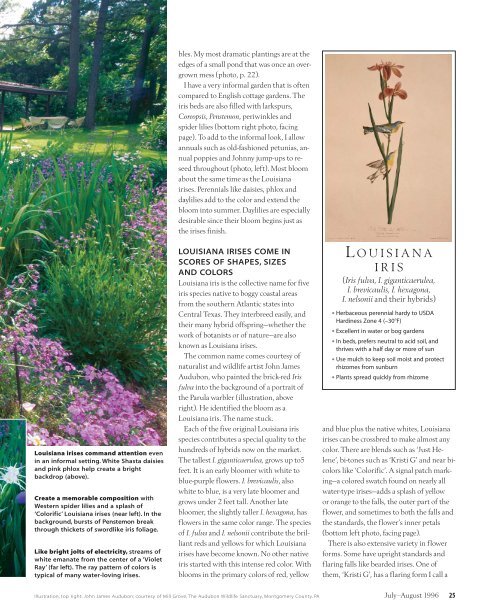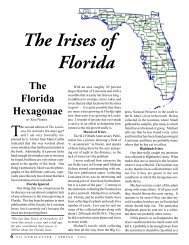Jazzy Louisiana Irises - Zydeco Louisiana Iris Garden
Jazzy Louisiana Irises - Zydeco Louisiana Iris Garden
Jazzy Louisiana Irises - Zydeco Louisiana Iris Garden
Create successful ePaper yourself
Turn your PDF publications into a flip-book with our unique Google optimized e-Paper software.
<strong>Louisiana</strong> irises command attention even<br />
in an informal setting. White Shasta daisies<br />
and pink phlox help create a bright<br />
backdrop (above).<br />
Create a memorable composition with<br />
Western spider lilies and a splash of<br />
‘Colorific’ <strong>Louisiana</strong> irises (near left). In the<br />
background, bursts of Penstemon break<br />
through thickets of swordlike iris foliage.<br />
Like bright jolts of electricity, streams of<br />
white emanate from the center of a ‘Violet<br />
Ray’ (far left). The ray pattern of colors is<br />
typical of many water-loving irises.<br />
bles. My most dramatic plantings are at the<br />
edges of a small pond that was once an overgrown<br />
mess (photo, p. 22).<br />
I have a very informal garden that is often<br />
compared to English cottage gardens. The<br />
iris beds are also filled with larkspurs,<br />
Coreopsis, Penstemon, periwinkles and<br />
spider lilies (bottom right photo, facing<br />
page). To add to the informal look, I allow<br />
annuals such as old-fashioned petunias, annual<br />
poppies and Johnny jump-ups to reseed<br />
throughout (photo, left). Most bloom<br />
about the same time as the <strong>Louisiana</strong><br />
irises. Perennials like daisies, phlox and<br />
daylilies add to the color and extend the<br />
bloom into summer. Daylilies are especially<br />
desirable since their bloom begins just as<br />
the irises finish.<br />
LOUISIANA IRISES COME IN<br />
SCORES OF SHAPES, SIZES<br />
AND COLORS<br />
<strong>Louisiana</strong> iris is the collective name for five<br />
iris species native to boggy coastal areas<br />
from the southern Atlantic states into<br />
Central Texas. They interbreed easily, and<br />
their many hybrid offspring—whether the<br />
work of botanists or of nature—are also<br />
known as <strong>Louisiana</strong> irises.<br />
The common name comes courtesy of<br />
naturalist and wildlife artist John James<br />
Audubon, who painted the brick-red <strong>Iris</strong><br />
fulva into the background of a portrait of<br />
the Parula warbler (illustration, above<br />
right). He identified the bloom as a<br />
<strong>Louisiana</strong> iris. The name stuck.<br />
Each of the five original <strong>Louisiana</strong> iris<br />
species contributes a special quality to the<br />
hundreds of hybrids now on the market.<br />
The tallest I. giganticaerulea, grows up to5<br />
feet. It is an early bloomer with white to<br />
blue-purple flowers. I. brevicaulis, also<br />
white to blue, is a very late bloomer and<br />
grows under 2 feet tall. Another late<br />
bloomer, the slightly taller I. hexagona, has<br />
flowers in the same color range. The species<br />
of I. fulva and I. nelsonii contribute the brilliant<br />
reds and yellows for which <strong>Louisiana</strong><br />
irises have become known. No other native<br />
iris started with this intense red color. With<br />
blooms in the primary colors of red, yellow<br />
Illustration, top right: John James Audubon; courtesy of Mill Grove, The Audubon Wildlife Sanctuary, Montgomery County, PA<br />
L OUISIANA<br />
IRIS<br />
(<strong>Iris</strong> fulva, I. giganticaerulea,<br />
I. brevicaulis, I. hexagona,<br />
I. nelsonii and their hybrids)<br />
◆ Herbaceous perennial hardy to USDA<br />
Hardiness Zone 4 (–30°F)<br />
◆ Excellent in water or bog gardens<br />
◆ In beds, prefers neutral to acid soil, and<br />
thrives with a half day or more of sun<br />
◆ Use mulch to keep soil moist and protect<br />
rhizomes from sunburn<br />
◆ Plants spread quickly from rhizome<br />
and blue plus the native whites, <strong>Louisiana</strong><br />
irises can be crossbred to make almost any<br />
color. There are blends such as ‘Just Helene’,<br />
bi-tones such as ‘Kristi G’ and near bicolors<br />
like ‘Colorific’. A signal patch marking—a<br />
colored swatch found on nearly all<br />
water-type irises—adds a splash of yellow<br />
or orange to the falls, the outer part of the<br />
flower, and sometimes to both the falls and<br />
the standards, the flower’s inner petals<br />
(bottom left photo, facing page).<br />
There is also extensive variety in flower<br />
forms. Some have upright standards and<br />
flaring falls like bearded irises. One of<br />
them, ‘Kristi G’, has a flaring form I call a<br />
July �August 1996 25



